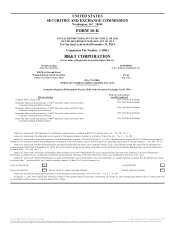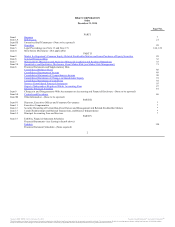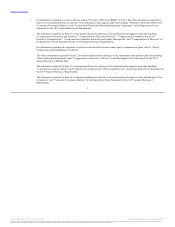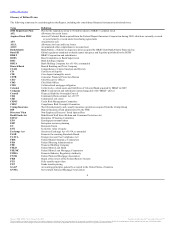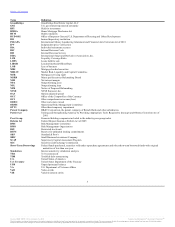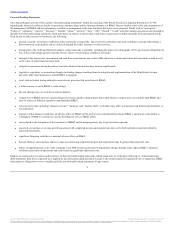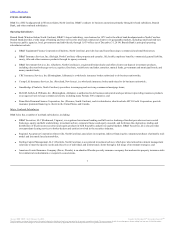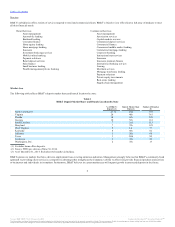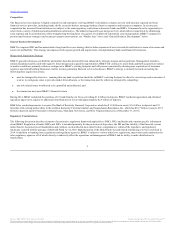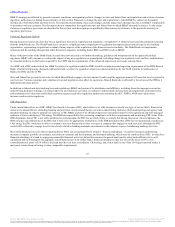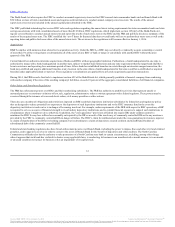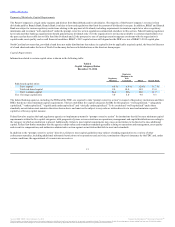BB&T 2014 Annual Report Download - page 12
Download and view the complete annual report
Please find page 12 of the 2014 BB&T annual report below. You can navigate through the pages in the report by either clicking on the pages listed below, or by using the keyword search tool below to find specific information within the annual report.
Table of Contents
Current federal law also establishes a system of functional regulation under which the FRB is the umbrella regulator for BHCs, but BHC affiliates are
principally regulated by functional regulators such as the FDIC for state nonmember bank affiliates, the SEC for securities affiliates and state insurance
regulators for insurance affiliates. Certain specific activities, including traditional bank trust and fiduciary activities, may be conducted in the bank without
the bank being deemed a “broker” or a “dealer” in securities for purposes of functional regulation. Although states generally must regulate bank insurance
activities in a nondiscriminatory manner, states may continue to adopt and enforce rules that specifically regulate bank insurance activities in certain
identifiable areas.
The Dodd-Frank Act also imposes new prudential regulation on depository institutions and their holding companies. As such, BB&T is subject to more
stringent standards and requirements with respect to (1) bank and nonbank acquisitions and mergers, (2) the “financial activities” in which it engages as a
FHC, (3) affiliate transactions and (4) proprietary trading, among other provisions.
Enhanced Supervision Standards for Systemically Important Financial Institutions
The Dodd-Frank Act requires the FRB to monitor emerging risks to financial stability and establish enhanced supervision and prudential standards
applicable to large, interconnected financial institutions, including BHCs like BB&T, with total consolidated assets of $50 billion or more (often referred to
as systemically important financial institutions). During February 2014, the FRB published the final rule implementing the enhanced prudential standards
required to be established under section 165 of the Dodd-Frank Act. The enhanced prudential standards include risk-based capital and leverage requirements,
liquidity standards, risk management and risk committee requirements, stress test requirements and a debt-to-equity limit for companies that the Council has
determined pose a grave threat to financial stability were they to fail such limits.
Resolution Planning and Regulation QQ
FRB and FDIC regulations require “covered companies” such as BB&T and systemically important financial institutions such as Branch Bank to file,
maintain and update plans for a rapid and orderly resolution in the event of material financial distress or failure (a “living will”). Both the FRB and the FDIC
must review and approve BB&T’s and Branch Bank’s living wills and are authorized to impose restrictions on BB&T’s and Branch Bank’s growth and
activities or operations if deemed necessary. The public portions of BB&T’s and Branch Bank’s resolution plans are available in the Additional Disclosures
section of the Investor Relations site at www.bbt.com.
CCAR and Stress Test Requirements
Current FRB rules require BB&T and other BHCs with $50 billion or more of total consolidated assets to submit annual capital plans based on pre-defined
stress scenarios. BB&T and other such BHCs are also required to collect and report certain related data on a quarterly basis to allow the FRB to monitor the
companies’ progress against their annual capital plans. Covered BHCs, including BB&T, may pay dividends and repurchase stock only in accordance with a
capital plan that has been reviewed by the FRB and as to which the FRB has not objected. The rules also require, among other things, that a covered BHC
may not make a capital distribution unless, after giving effect to the distribution, it will meet all minimum regulatory capital ratios and have a ratio of Basel I
Tier 1 common capital to risk-weighted assets of at least 5%. In addition, effective January 1, 2015, BB&T must maintain a Basel III common equity tier 1
ratio of at least 4.5%. See Table 3 for additional information about Basel III requirements. The FRB did not object to BB&T’s 2014 capital plan. The 2015
capital plan was submitted during January 2015.
The Dodd-Frank Act requires the FRB to conduct an annual supervisory stress test for BHCs, such as BB&T, with $50 billion or more of total consolidated
assets. The FRB’s stress test rules also require that BB&T (as well as other covered BHCs) conduct a separate mid-year stress test, file the results of such test
with the FRB and publicly disclose details of the scenario and the impact on its capital. BB&T’s annual and midcycle stress test results are available in the
Additional Disclosures section of the Investor Relations site on www.bbt.com.
During October 2014, the FRB adopted a rule that amends the capital plan and stress test rules to modify the start date of the capital plan and stress test cycles
from October 1 to January 1 of the following calendar year. This rule is effective for 2015. The rule also amends the capital plan rule to limit a BHC’s ability
to make capital distributions to the extent the BHC’s actual capital issuances are less than the amount indicated in its capital plan under baseline conditions,
measured on a quarterly basis.
11
Source: BB&T CORP, 10-K, February 25, 2015 Powered by Morningstar® Document Research℠
The information contained herein may not be copied, adapted or distributed and is not warranted to be accurate, complete or timely. The user assumes all risks for any damages or losses arising from any use of this information,
except to the extent such damages or losses cannot be limited or excluded by applicable law. Past financial performance is no guarantee of future results.


